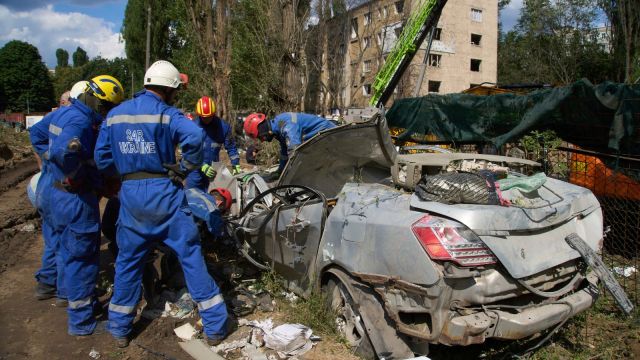Ukraine Strikes Deep: Drone Assaults Hit Russian Oil Heartland, Military Bases in Escalating Long-Range War
The acrid smell of burning oil wafted over Ryazan on Saturday. Far from the muddy, artillery-scarred trenches of eastern Ukraine, a major refinery just 180 kilometres southeast of Moscow – very close to the Russian capital’s elite – became the latest symbol of Ukraine’s evolving ability to take the war to Russia. Along with attacks on a key oil depot, a military drone base, and a military electronics factory, the attack marks not just tactical strikes but also a strategic escalation in Ukraine’s long-range drone campaign, striking at the arteries of Russian military and economic power.

The Targets: Precision and Pain
Ukraine’s military announcements, delivered via Telegram on Saturday, painted a picture of coordinated, deep-penetration strikes:
- Ryazan Oil Refinery: This isn’t just any refinery. Operated by Rosneft, Ryazan is one of Russia’s largest, processing a significant chunk of the nation’s crude. A fire erupting on its premises, as reported by Ukraine’s Unmanned Systems Forces (USF), isn’t merely a temporary shutdown. It’s a direct blow to Russia’s refined fuel production, a vital commodity for both its domestic economy and, crucially, its military machine grinding away in Ukraine. Tanks, trucks, and jets all run on the products refined here. The psychological impact of a successful strike so deep inside Russia, near Moscow, cannot be overstated. It screams vulnerability.
- Annanefteprodukt Oil Depot (Voronezh Region): Located perilously close to Ukraine’s northeastern border, this storage facility is a key logistical node. Hitting storage doesn’t just destroy existing fuel; it disrupts the complex supply chains feeding Russian forces near the frontlines like the ongoing assault towards Kharkiv. Destroying fuel where it’s stored is far more efficient for Ukraine than trying to hit individual fuel trucks near the front.
- Primorsko-Akhtarsk Military Airfield (Krasnodar Krai): This target, claimed by Ukraine’s SBU security service, is deeply personal. This airbase isn’t for fighter jets; it’s a launchpad for Russia’s own long-range Shahed drones – the very “mopeds” that relentlessly terrorize Ukrainian cities, targeting power plants, apartment blocks, and civilian infrastructure. Striking this base is a direct attempt to degrade Russia’s capacity to launch these devastating, often indiscriminate attacks. It’s Ukraine saying, “We know where you launch from, and we can hit you there.”
- Penza Electronics Factory: This strike, also claimed by the SBU, points to Ukraine’s strategic aim of crippling Russia’s future war-fighting capacity. The unnamed factory is alleged to be a critical supplier to Russia’s military-industrial complex. Destroying specialized machinery and components sets back production lines for missiles, drones, communication systems, and other vital military tech. It’s an attack not just on today’s capabilities, but on Russia’s ability to sustain the war tomorrow and next year.
The Weapon: Ukraine’s Homegrown Long-Range Fist
Although no Ukrainian military official gave a clear description of the delivery method of each attack, the imprint of their specialized drone units is everywhere in this campaign. The USF, as their name implies, is the pioneer of Ukraine’s drone warfare revolution. The SBU has also developed formidable covert attack capabilities using drones.
This capability is a stark contrast to the early frustrating days of the full-scale invasion in February 2022. At that time, Ukraine watched helplessly as Russian cruise missiles fired from deep within Russia or from warships in the Black Sea rained down on its cities and military installations. Ukraine had no credible long-range firepower of its own to respond to or intercept these attacks.
What followed was a remarkable feat of ingenuity and determination amid a firefight. Faced with an enemy that had far superior conventional long-range firepower, Ukraine turned to asymmetric warfare. Taking advantage of commercial components, open-source technology, and pure battlefield innovation, Ukrainian engineers and military units pioneered the development of long-range “kamikaze” drones. These are not tiny quadcopters hovering over trenches; they are fixed-wing aircraft, often looking like small, crude airplanes, capable of flying autonomously for hundreds, possibly even more than a thousand, kilometers while carrying heavy explosive loads.
They are relatively inexpensive compared to missiles, difficult to detect by radar due to their small size and low altitude, and can be launched from improvised bases deep within Ukraine. This fleet represents Ukraine’s hard-earned ability to project power beyond its borders and strike deep into the heartland of Russia — an ability that would have been unimaginable two years ago. Saturday’s coordinated attacks are the most powerful demonstration yet of this maturing capability.
The Echo Chamber: Claims, Counter-Claims, and the Fog of War
Predictably, the immediate aftermath was a swirl of conflicting narratives:
- Russian Silence (on Infrastructure): Notably, Russian authorities offered no immediate comment on the strikes against the Ryazan refinery, the Voronezh depot, the Penza factory, or the Primorsko-Akhtarsk airfield. This silence is often telling. While they may issue denials or downplay damage later, the initial lack of response sometimes precedes confirmed reports of fires or damage emerging locally.
- Russian Air Defense Claims: Russia’s Defense Ministry, in its daily briefing, presented a staggering figure: 338 Ukrainian drones shot down overnight across various regions. This number, if taken at face value, would represent an unprecedented wave of attacks. However, Russian reports consistently fail to provide crucial context: the total number of drones launched. Without that denominator, the claimed interception rate (100%?) is impossible to verify and often viewed skeptically by Western analysts. It serves domestic propaganda, portraying robust defenses, but obscures the reality that some drones inevitably get through – as evidenced by the fires at Ryazan.
- Ukrainian Air Defense Claims: Ukraine’s Air Force reported intercepting 45 out of 53 Russian drones launched against Ukrainian territory overnight. While also subject to verification challenges, this claim includes the total number launched, allowing for an interception rate calculation (around 85% in this instance), aligning more closely with typical Western assessments of Ukrainian air defense effectiveness, especially against slower drones like the Shahed.
The Grinding Eastern Front: Incremental Gains at High Cost
While the drones were attacking in the interior of Russia, the brutal and destructive conflict on the ground in eastern Ukraine continued at its frightening pace. The Russian Defense Ministry claimed to have captured Oleksandro-Kalinov, a small village in the war-torn Donetsk region. Such claims, frequent in daily briefings, highlight Russia’s slow and costly offensive strategy: massive deployment of infantry and armor against fortified Ukrainian positions, advancing one meter at a time village by village and suffering heavy losses in the process.
Reuters, like other international news agencies, could not immediately confirm this specific claim. The capture of a village, though symbolically important for Russian propaganda, does not do much to change the strategic picture of Donetsk in the short term. However, it underscores the persistent pressure on Ukraine’s vast front line, where Russian forces, despite heavy casualties, continue to push forward in search of any advantage.
The Bigger Picture: Territory, Time, and Tenacity
After three and a half years of conflict (including the pre-2022 fighting in Donbas) and nearly two and a half years of full-scale invasion, the territorial reality remains grim for Ukraine. Russian forces control almost 20% of Ukraine’s internationally recognized territory, a vast swathe encompassing parts of the Donetsk, Luhansk, Zaporizhzhia, and Kherson regions, along with Crimea. This represents a significant strategic loss.
However, Saturday’s drone strikes illuminate a different aspect of the war: Ukraine’s resilience and capacity for strategic adaptation. Unable to match Russia’s conventional military mass or long-range missile arsenal head-on, Ukraine has carved out a potent niche in drone warfare. These strikes serve multiple purposes:
- Military Degradation: Disrupting fuel supplies, destroying launch sites for attack drones, and damaging military electronics production directly weakens Russia’s ability to wage war.
- Economic Pressure: Hitting critical energy infrastructure like major refineries aims to strain Russia’s economy, potentially reducing oil revenues that fund the war and forcing domestic fuel price adjustments or export restrictions.
- Psychological Impact: Demonstrating an ability to strike deep inside Russia, near symbolic centers of power like Moscow, challenges the Kremlin’s narrative of security and normalcy for the Russian population. It brings the tangible costs of the war home.
- Strategic Signaling: To Western allies, these strikes show Ukraine is actively taking the fight to Russia, leveraging provided technology and their own ingenuity, arguing for continued support. To Russia, it signals that no target is truly safe.
A New Phase of Endurance and Escalation
The fire in Ryazan and the explosion in Primorsko-Akhtarsk are not just isolated incidents. They mark a critical moment in the war. Ukraine has transformed from a nation focused solely on territorial defense to a nation capable of launching sophisticated, coordinated long-range strikes on high-value strategic targets deep within Russia. This represents a new phase – one defined by endurance, technological adaptation, and an escalating campaign aimed at crippling Russia’s war machine at its very logistical and industrial roots.
Russia’s lack of immediate comment on the loss of infrastructure speaks volumes, while their exaggerated drone shootdown claims highlight the information war running alongside the physical conflict. The slow, bloody capture of villages like Oleksandro-Kalinov reminds us of the horrific human price paid daily on the front lines. Ukraine’s ability to continue this deep-strike campaign, while holding its ground against Russian ground assaults amid relentless bombardment, will be crucial in the difficult months ahead. The war has entered a new dimension, being fought not just in the trenches of Donbass, but also at refineries near Moscow and drone bases on the Black Sea coast.
Follow us for more news at Valleynewz.com

